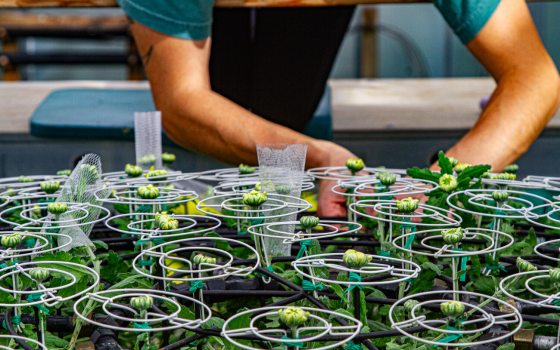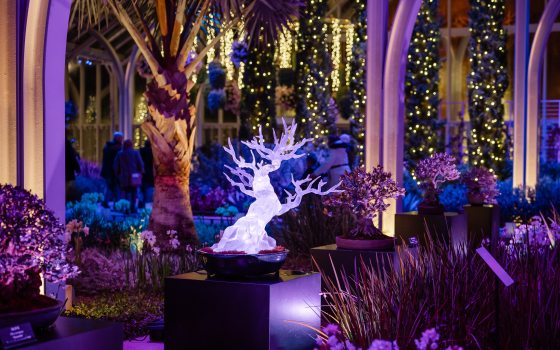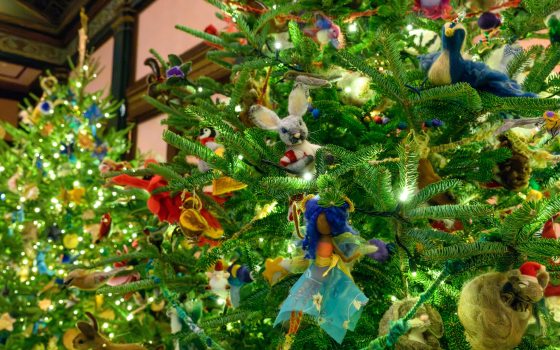Working with plants is undoubtedly a science—but it’s also an artform rooted in patience, collaboration, resilience, and adaptability. Just like plants themselves, we at Longwood are adaptable—especially when the living things we’re working with don’t respond the way in which we planned. When that happens, we regroup, we replan, and we readapt—just like we’ve recently had to do with our Thousand Bloom Chrysanthemum, which—after an arduous journey to get it there—is now on view in our Main Conservatory. Showcasing 1,366 flowers on a single plant and stretching more than 12 feet in diameter—making it the widest Thousand Bloom we have ever grown at Longwood—this year’s Thousand Bloom of Chrysanthemum × morifolium ‘Susono-no-Hikari’ started its journey as a vegetative cutting 18 months ago—and today is not only a sight to behold, but a culminating example of the unchanging beauty and art of people and plants working together. What’s more, we are particularly proud of this Thousand Bloom as it also represents the triumphant return of the Thousand Bloom form to our display following a two-year absence.
Growing the Thousand Bloom Chrysanthemum, known in Japan as Ozukuri, is a difficult and precarious process and technique that originated in China and expanded to Japan several hundred years ago. The goal of the technique is growing an extremely large chrysanthemum and producing the maximum number of flowers possible on a single plant. In preparation for each Chrysanthemum Festival, our expert horticulturists grow and nurture our Thousand Bloom throughout a horticulturally intense, 18-month-long process of growing, pinching, and tying of the chrysanthemum to its customized frame. After a wilting period to allow the stems to become more flexible, we arrange the blooms in a dome shape, in pursuit of the goal of achieving as many uniform blooms as possible on a single plant. If that doesn’t sound difficult enough, the technique also requires that there is only a single bloom on the end of each individual branch; none of the flowers on the sides of the branch can be used. To further complicate matters, each flower must be perfectly placed in concentric horizontal rows on a dome-shaped frame.
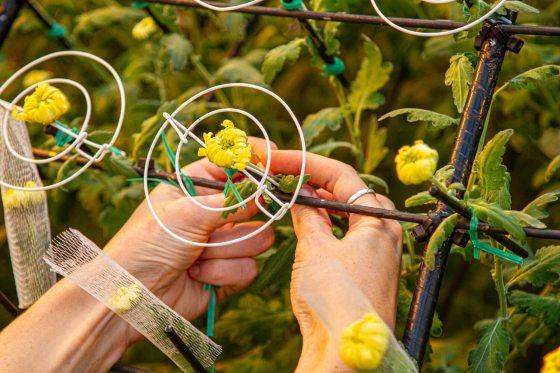
Growing our Thousand Bloom Chrysanthemum is the most horticulturally intense technique we do at Longwood. Photo by Joe Hare.
This process begins from scratch for each Thousand Bloom and for each display year. Bringing this year’s Thousand Bloom to display required teamwork and coordination across many teams. As Floriculture Manager Kevin Murphy shares, “Growing the Thousand Bloom Chrysanthemum is truly a team effort that involves staff from across many different sections of Longwood—but none more important than the grower. The Thousand Bloom Grower is the one making the daily decisions that culminate into the end product you see on display.”
Thousand Bloom Chrysanthemums made their display debut at Longwood in 2009 and throughout those years we have had three Thousand Bloom experts hone this craft, all of whom have been women. Our first Thousand Bloom grower, Yoko Arakawa, identified this technique as something she wanted to learn and bring to Longwood and spent years training with Thousand Bloom experts in Japan and adapting the technique for our conditions at Longwood. Since that time, Thousand Bloom Chrysanthemums have been a central facet of our Chrysanthemum Festival.
The Thousand Bloom on view today is the crowning achievement of the combined efforts of two of these women: Amanda Galano and Emily Coghlan. Galano was trained by Arakawa before taking the Thousand Bloom lead in 2017. In 2022 Coghlan began apprenticing with Galano before officially taking the Thousand Bloom reins in May 2023 and guiding our 2023 Thousand Bloom successfully to display. “It has been an honor to continue the Thousand Bloom tradition,” shares Coghlan. “I am grateful to Amanda for her incredible training and continued guidance as I moved into this new role, and for my dedicated team who helped make this possible.”
There are no guarantees that our Thousand Bloom will grow and respond as we expect—plants are living things. Every year, we begin growing 10 plants as contenders for the Thousand Bloom Chrysanthemum to eventually go on display. Each of the 10 plants are numbered and cared for until the November or December prior to the display year. At that point, a team made up of our Thousand Bloom Senior Grower, Floriculture Production team and Integrated Pest Management team select two of the 10 plants to be transplanted into their final container, and for care to continue for those two plants; the others are composted. To make that selection, we evaluate such criteria as overall shape and vigor, plant and root health, and balance of root and shoot growth. This year’s Thousand Bloom Chrysanthemum now on display is the sole survivor of the two Thousand Blooms that were selected to move forward for this year—and it serves as a stark reminder of the razor’s edge on which the successful production of this plant falls.
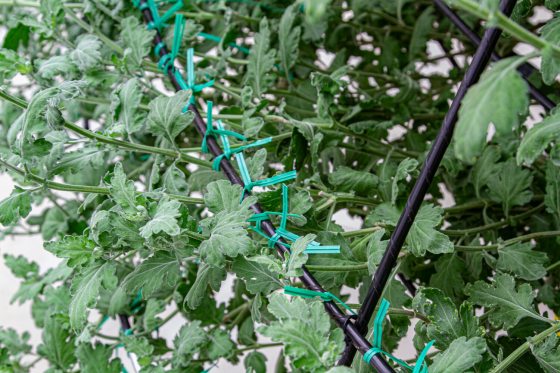
The intensity of the Thousand Bloom tying technique is shown here, affixing each flowering step to the frame in this late August photo. Photo by Joe Hare.
Two years ago, in preparation for the 2021 Chrysanthemum Festival, our Thousand Bloom showed signs of stress and decline in mid-October. While preparing it for final display, we determined that its appearance did not meet our standard to go on display … and we had to make the difficult decision to not display it during our 2021 Chrysanthemum Festival. In its place, we displayed two smaller Thousand Bloom Chrysanthemum forms, which showcased the result of the single-stem growth habit reminiscent of a traditional Thousand Bloom Chrysanthemum, but were not true Thousand Bloom Chrysanthemums as they did not have more than 1,000 flowers as part of each single plant.
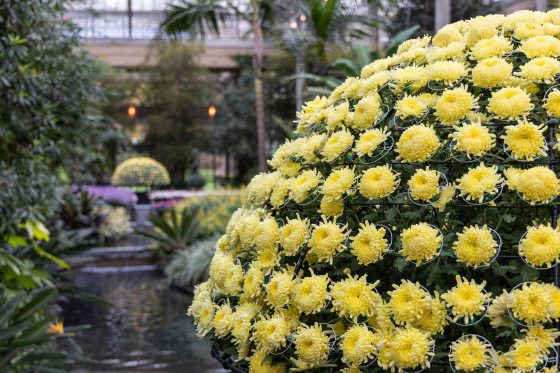
Our 2021 Chrysanthemum Festival display featured two smaller Thousand Bloom-reminiscent forms of Chrysanthemum × morifolium ‘Susono-no-Hikari’. Photo by Carol DeGuiseppi.
In 2022, most unfortunately, our Thousand Blooms experienced the similar decline in September and we again had to make the decision to not display a Thousand Bloom Chrysanthemum during our 2022 Chrysanthemum Festival. In its place, we did display a half-dome form reminiscent of a Traditional Thousand Bloom Chrysanthemum, but again was not a true Thousand Bloom.
Our team knew that our 2021 and 2022 Thousand Blooms’ decline was ultimately a result of succumbing to different root-borne pathogens; however, what we needed to get to the bottom of was identifying the elements that contributed to that susceptibility. Growing a Thousand Bloom Chrysanthemum requires constant attention over the more than 500 days it takes to reach our display—so one can only imagine the loss and disappointment felt by the team two years in a row. As horticulturists, we have all experienced the loss of a plant—but we see it as an opportunity to learn and inform what to do (or not do) next time to find success. Thankfully, as horticulturists and scientists we are incredibly good investigators, and so after changes from the first loss did not result in a positive outcome for the second, we dug deeper to figure out what was causing these root-borne pathogens to take hold and make our plants succumb in the eleventh hour.
In response to what happened in 2021 and 2022 and our findings about what happened those years— and in preparation for the Thousand Bloom Chrysanthemum that’s now on display for our current Chrysanthemum Festival—we evolved the technique in hopes that the Thousand Bloom would respond and grow as we hoped it would. And we are beyond thrilled that it did respond to our adapted approach. Root-borne pathogens are not uncommon in horticulture and best practices start with maintaining clean and sanitary spaces. We started here and implemented a phytosanitary program that limited access to the greenhouses where the Thousand Bloom was being grown, and increased the sanitation steps required for anyone who entered those greenhouses and interacted with the plants.
Next, we focused on the growing environment, noting that the two plants we lost were a bit disproportionate when it came to the ratio between shoot and root growth, favoring the shoots. This was an important factor to address, as once the plant reaches critical size and is moving all of its energy to producing flowers, if the plant does not have a sufficient root mass to provide the water and nutrition needs of the plant, it can result in a drought-stress response—which can make the plant more susceptible to pathogens.
We are fortunate to have state-of-the-art greenhouses that allow us to customize and tailor the environmental conditions to the plant’s requirements, but it also means that we have to have an even deeper understanding of how every variable in this simulated environment affects the growth of the plant. After the loss of the 2022 Thousand Bloom, we isolated each of these variables to assess and quantify those impacts: day and night temperatures, light levels and intensities, cooling and heating setpoints, and humidity all contribute collectively to plant development.
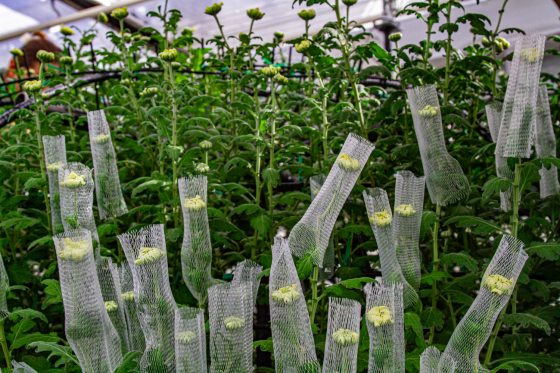
Final preparations for this year’s Thousand Bloom Chrysanthemum, as shown in this early October shot. Photo by Joe Hare.
Looking back at the data we collected during the plants’ various growth stages, we noted that shoot growth was higher in the winter months for the past two years, as a result of a combination of elevated night temperatures and light intensities that caused elevated shoot growth. We were able to respond to this by reducing the light intensity and night air temperature to reduce shoot growth, while slightly increasing the floor temperature to improve root growth. Through these adjustments, we reclaimed a more balanced root to shoot ratio.
Additionally, we elevated our preventative management program to favor beneficial root-borne microbes and create an unfavorable environment for the pathogens. Then we focused on watering. Overwatering a plant can result in suffocating the roots, creating an aerobic environment that favors the growth and development of certain fungal and bacterial pathogens that attack roots. This can be further exacerbated if the plant is allowed to get too dry, as it can cause the root tips to burn, which—coupled with overcompensating with too much water—can encourage pathogens to infect the damaged tissue. While we were treating the soil to make sure those pathogens were minimally, if not at all present, we felt it was still important to maintain as steady a soil moisture content as possible. We accomplished this by limiting watering to a select number of growers specifically trained on how to water the Thousand Bloom. Watering is done by a ladle and the number of scoops of water required are counted with every irrigation.
Every action to maintain, guide, and support influences the growth and health of this plant. The container the plant is grown in is constructed in-house by our Facilities team, with special panels along each side that can be removed for periodic checking on the root development and distribution of soil moisture. The soil mix is custom-blended to balance optimal water-holding capacity, air space, and buffering. Plant tissue and soil tests are taken at regular intervals to monitor nutrient concentrations to help inform fertility requirements.
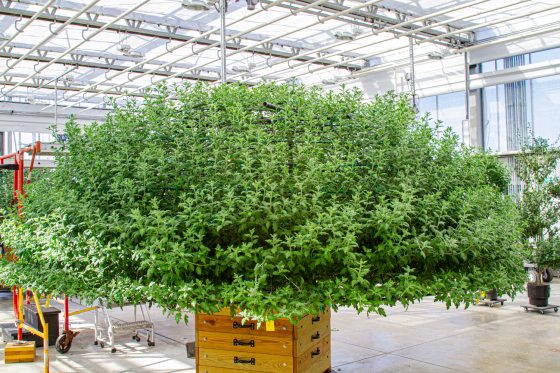
This mid-September photo shows our Thousand Bloom growing in the new box. Photo by Joe Hare.
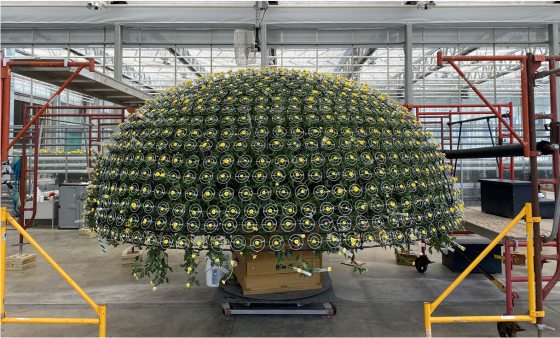
This shot shows our Thousand Bloom about a week before display once the rindai have been fully affixed to the mum. Photo by Emily Coghlan.
Layered on top of the foundational horticulture that ensures the health of the plant is the technique of training each of its stems to form a dome and showcase the maximum number of disbudded flowers possible. This is the most horticulturally intense technique we do here, requiring systematic pinching and tying to a customized frame created in-house by our Facilities team. Each flower is hand-tied and evenly spaced in concentric horizontal rows before affixing each flower with a support or rindai to help balance the weight and hold the flower position in place. The dome is also customized to each individual Thousand Bloom we produce, based on its specific measurements.

A closer view of our Thousand Bloom Chrysanthemum about a week before display. Photo by Joe Hare.
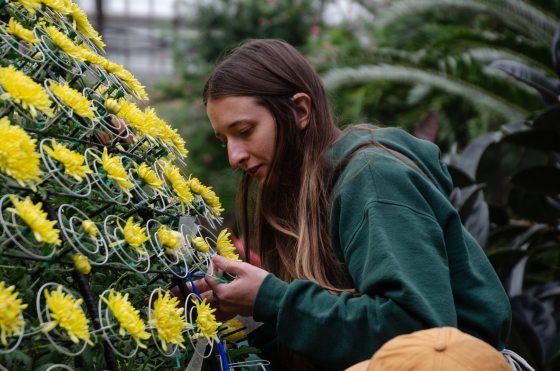
Senior Grower Emily Coughlan makes final touches as the Thousand Bloom Chrysanthemum goes on display in our East Conservatory. Photo by Amy Simon Berg.
At the end of the day—or at the end of an 18-month process in this case—it’s not just our plants that make our displays possible—it’s our people. It’s their adaptability, their resilience, their expertise, and their passion for what—and all—they do. A mere snapshot of all they do is represented in each and every of the 1,366 blooms of this year’s Thousand Bloom Chrysanthemum and the thousands of hours behind this impressive plant. We are so pleased to once again share the beauty of the Thousand Bloom—and the many, many people behind its creation—with you.
Editor’s note: Our Thousand Bloom Chrysanthemum is on display, with the rest of Chrysanthemum Festival, now through November 12.
